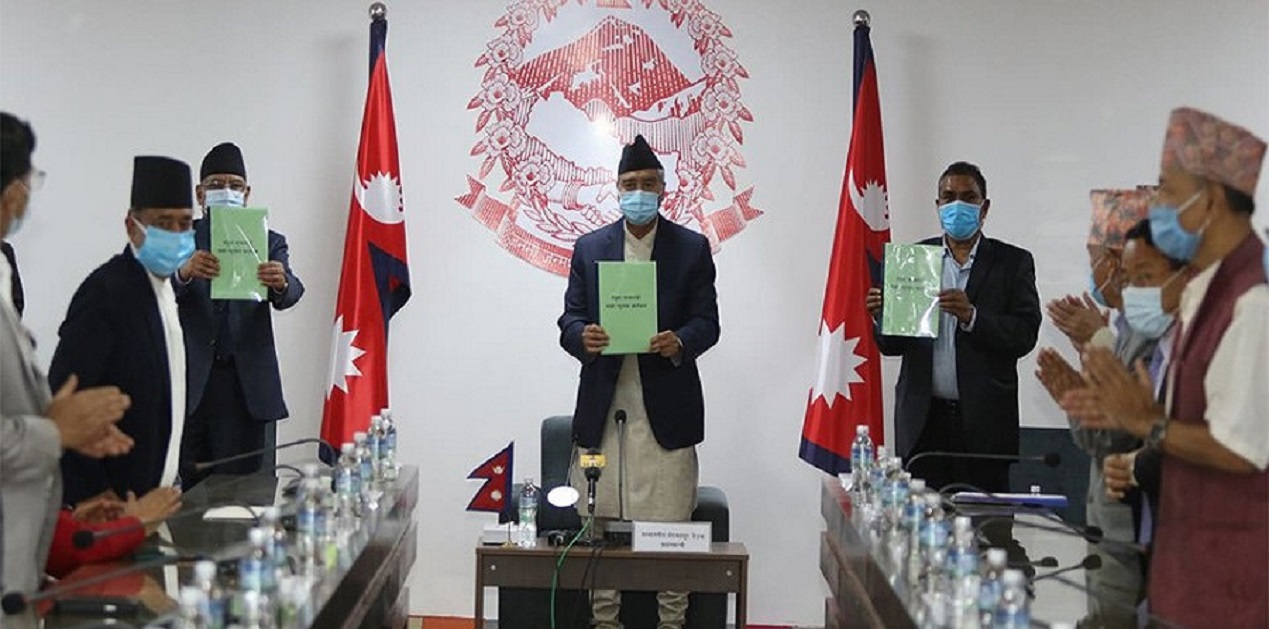The Backdrop
Prime Minister Sher Bahadur Deuba led Government in Nepal unveiled a Common Minimum Programme (CMP) on August 08, 2021.1 In less than a month in office, Deuba has launched the CMP as a systematic planning model to address governance, politics, and foreign policy issues in the next one and a half years. On July 13 2021, the Nepali Congress Party President Sher Bahadur was appointed as the Prime Minister after the Supreme Court verdict on July 12, which quashed an interim Government led by KP Sharma Oli. With 63 seats in the Lower House of the Parliament, Nepali Congress is supported by Pushpa Kamala Dahal Prachanda led Nepal Communist Party (Maoist Center), Upendra Yadav led Janta Samajbadi Party and Madhav Kumar Nepal faction of Communist Party of Nepal (UML).
The merger of the two largest political parties, namely the Communist Party of Nepal (UML) led by KP Oli and the Maoist Center led by Prachanda in one Nepal Communist Party during the 2017 general elections, was seen as a mature move towards political stability. The coalition won the largest political mandate, and Oli was appointed as the Prime Minister. However, as per the understanding, Prachanda was to lead the government for the latter half, which Oli refused to accept. As a result, the party was divided and later reverted into its old form. Oli tried to sustain his totalitarian model of power through constitutional interpretations and his influence on the Office of the President in getting new laws, bills, and recommendations passed overnight, including dissolving the parliament twice, but the judiciary prevailed at last.
Common Minimum Programme
CMP is probably the only way to bring in consensus among four ideologically divided parties with a short-term new government in place. In principle, the CMP is a fourteen-page document promising to address a range of issues, including COVID-19, federal governance, economy, health, education, unemployment, peace and security, foreign policy, and border issues. CMP also manages to launch a derisive attack on the previous Oli government from beginning to end. Without naming KP Oli, the CMP promises to adopt a progressive and decisive approach as against the “totalitarian” forces that indulged in unconstitutional acts like dissolving the parliament, irregularities in purchasing vaccines, and corruption in purchasing medical equipment to fight COVID-19. Such strong words in the CMP had infuriated KP Oli, who in his address in the parliament on August 11 criticised and challenged the government.2 There was a heated exchange of arguments between former allies KP Oli and Prachanda in the parliament on the intentions of CMP.
Political Instability
In 15 years of democratic history, the compulsion of the coalition has become an important ingredient in Nepalese politics. Since the first democratic elections in 2008, no single party has managed majority of its own in the parliament. As a result, mainstream political parties have formed governments in the coalition. However, self-centred and interest-based coalitions have always fallen due to their short-sightedness in domestic and foreign policy matters. Meanwhile, the 2017 coalition between CPN-UML and Maoist Center followed by their merger was a hallmark development as it ended a strong opposition to UML posed by the Maoists. The Left-alliance had the least chances of running into minority government in any circumstances. However, the situation turned out to be otherwise, and the NCP government eventually fell due to personal follies.
The Madhesh Factor
In the present context, Prime Minister Deuba led government is supported by Madhesh based Janta Samjbadi Party. Hence, a substantial space and due regard is given to the Madhesi factor in the CMP. Categorically, the CMP duly acknowledges and gives due importance to the Madhesi Andolan of 2015 against the popular majoritarian Pahadi elite notion of disregarding and demeaning it. Also, under Article 1.4, the CMP calls for the “amendment of the constitution with the consent of the political parties.” Notably, Madhesis have been demanding to amend provision related to citizenship and political representation in the new constitution. The Nepali Congress government had ignored these demands while implementing the constitution in October 2015, which resulted in a large scale Madhesi Andolan with several lives lost. The same Nepali Congress has not only given due recognition to the same Andolan but also promises to amend relevant provisions. In a clear case of a political bargain, Article 2.5.4 commits to releasing protestors who were arrested and jailed during 2015 Madhesi Andolan.
Socio-Economic Challenges
In 2020, Covid-19 coupled with political instability had imbalanced the economic trajectory of Nepal. The World Bank, in its South Asia Economic Focus reported that for FY 2020, Nepal had a growth rate of 0.2 percent and “trade disruptions resulted in a collapse in imports and narrowed the current account deficit.”3 Some of the main pillars of the Nepalese economy, including Tourism and remittances, were also affected by the COVID-19. The Government of Nepal had declared 2020 as the tourism year by launching “Visit Nepal 2020”. However, within weeks of its formal launch in January 2020, Nepal had reported its first Covid-19 case. By mid-March 2020, new cases were reported, and the government had to halt the campaign. It was probably the largest investment made by the Government of Nepal in promoting Tourism.
Nepal was hoping to attract millions of tourists, especially Chinese, as President Xi had signed an agreement in October 2019 to send more tourists. Covid-19 has been a complete disaster for the tourism industry. To address it, Article 1.8 of CMP aims to revive affected industries, tourism, communication, transportation, and the entertainment industry. It also promises to provide economic assistance to workers, unemployed, and underprivileged communities. There is an emphasis on improving industrial production and uses of swadeshi products. In a digitally interconnected world, “Digital Nepal” is also given a fresh boost.
On the social front, CMP offers to provide social security, poverty alleviation, employment, small and medium scale business opportunities, better health facilities and improved agricultural practices. Also, the law and order situation will be improved to address discrimination and violence against women. In recent years, Nepal has seen an increase in the number of acid attacks against women.4 In September 2020, the government had introduced an ordinance criminalising acid attacks and “broadening the area of penalisation for the perpetrators.”5 While the actions on the ground concerning law and order remains to be seen, governments in Nepal have failed time and again to provide justice to the victims of still prevalent slavery practices like Kamaiya, Kamlari, Haliya, among others.
Millennium Challenge Corporation
Article 2.10 of CMP discusses Nepal’s international relations and wishes to establish cordial relations with neighbours. However, Millennium Challenge Corporations (MCC), a United States foreign assistance programme, aiming to “increase the availability of electricity, investments, lower-cost transportation, infrastructure development, support regional security and reduce poverty” does not find any mention.6 The Government of Nepal signed the MCC on September 14, 2017, with the US. Under the MCC, the US government will provide a grant worth USD 500 million.7 However, in the last four years, the government remains undecided to ratify in the parliament. Noteworthy, MCC was signed soon after Nepal signed China’s most ambitious Belt and Road (BRI) Initiative in May 2017, and it was seen as a counter to Chinese interests in Nepal. Chinese anxieties over MCC were reflected from its media reports tagging MCC as “political interference in host countries”.8
While Nepali Congress is willing to ratify it, Maoist Center claims that it is part of the Indo-Pacific strategy and has a security element.9 Despite the US Government issuing clarifications, Prachanda’s bonhomie with Beijing overpowers Prime Minister Deuba’s willingness. To recall, China had successfully manoeuvred in Sri Lanka on MCC, resulting in the US withdrawing it from Sri Lanka due to a “lack of engagement” by the host country.10 Beijing is using a similar tactic in Nepal. While Prachanda opposes MCC, he was instrumental in bringing BRI to Nepal.
At present, Nepal is in dire need of financial assistance in bettering the health facilities across Nepal, and MCC may very well serve the purpose. However, compulsions of coalition play as spoiler.
Relations with India
The bilateral relations with India touched the lowest point under Prime Minister KP Oli. The border row in the Kalapani region in October 2019 and May 2020 had escalated anti-India social media campaigns. However, tensions had become acute after KP Oli released a new political map showing India’s sovereign territorial regions as part of Nepal in the updated map in May 2020. India had objected to Nepal’s “unilateral act (which) is not based on historical facts and evidence.” India also said, “it is contrary to the bilateral understanding to resolve the outstanding boundary issues through diplomatic dialogue.”11 In addition to an enlarged map, KP Oli had reportedly mocked India’s national emblem and altered historical facts on the birthplace of Hindu God Ram.12
While India has maintained that it is ready to resolve Nepal’s border concerns through the existing Joint Commission, Oli opted to use it as a tool to posture his ultra-nationalistic outlook to gain political mileage. Although the opposition parties had supported Oli on the new map, they differed from how Oli used the event to his political benefit. Contrary to Oli, the CMP aims to resolve the “Limpiyadhura, Kalapani and Lipulekh issue…through the bilateral diplomatic mechanism.”13 Although it is a welcome step for India by the Deuba government, an enlarged map of Nepal will not be challenged or restored due to obvious political reasons. Hence, considering a short-term at hand in office and the delicate nature of the issues, including border, MCC, and political will, Prime Minister Deuba will have a tough time in running the government.
Conclusion
To conclude, Prime Minister Deuba led coalition government is yet to expand its cabinet due to a lack of consensus among the parties on portfolios. With just five members in his cabinet, including Deuba himself, political stability hangs on a thin layer of expectations and hopes. Therefore, Nepal may witness another phase of looming political instability as the existing political realities provide a meagre space for an ambitious CMP to become a reality.
References
- “संयुक्तसरकारकोसाझान्यूनतमकार्यक्रम/Sanyukt Sarkar Ko Sajha Nyuntam Karyakram”, Government of Nepal, August 08, 2021,https://bit.ly/3AKhhTP
- “Oli launches scathing attack on the ruling alliance, the common minimum programme”, The Kathmandu Post, August 11, 2021, https://tkpo.st/3Ax51pk
- “South Asia Economic Focus”, The World Bank, Fall 2020, https://openknowledge.worldbank.org/bitstream/handle/10986/34517/9781464816406.pdf
- Meenakshi Ganguly, “Victory for Acid Attack Campaigners in Nepal”, Human Rights Watch, October 01, 2020, https://www.hrw.org/news/2020/10/01/victory-acid-attack-campaigners-nepal
- “Nepal adopts ordinance against acid attacks, culprits to face 20 years in jail”, ANI, September 25, 2021, https://www.aninews.in/news/world/asia/nepal-adopts-ordinance-against-acid-attacks-culprits-to-face-20-years-in-jail20200925202819/
- “Nepal Compact”, Millennium Challenge Corporations, United States of America, https://www.mcc.gov/where-we-work/program/nepal-compact
- “Nepal Compact Signing Ceremony”, Millennium Challenge Corporations, United States of America, September 14, 2017, https://www.mcc.gov/news-and-events/event/signing-091417-nepal
- “US aid programs agency MCC meets increasing resistance for political interference in host countries”, Global Times, October 14, 2020, https://www.globaltimes.cn/page/202010/1203501.shtml
- “MCC ratification uncertain as ruling alliance struggles to take a position”, The Kathmandu Post, August 12, 2021, https://tkpo.st/3xJuDO2
- “Sri Lanka Compact”, Millennium Challenge Corporations, United States of America, December 2020, https://www.mcc.gov/where-we-work/program/sri-lanka-compact
- “Official Spokesperson’s response to media queries on the revised map of Nepal released today by Government of Nepal”, Ministry of External Affairs, New Delhi, India, May 20, 2020, https://bit.ly/3fZsLdY
- Nayanima Basu, “Mocking Indian emblem, redrawing Nepal map, KP Oli’s adventures are growing”, The Print, May 23, 2020, https://bit.ly/3iFp138
- “Sanyukt Sarkar Ko Sajha Nyuntam Karyakram,” Government of Nepal, August 08, 2021,https://bit.ly/3AKhhTP
(The paper is the author’s individual scholastic articulation. The author certifies that the article/paper is original in content, unpublished and it has not been submitted for publication/web upload elsewhere, and that the facts and figures quoted are duly referenced, as needed, and are believed to be correct). (The paper does not necessarily represent the organisational stance... More >>
Image Source: https://www.fiscalnepal.com/wp-content/uploads/2021/08/Programme-Govt.jpg










Post new comment